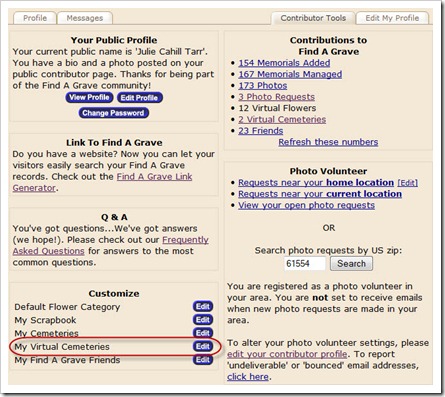
For 26 weeks I will take you on a family history journey through the alphabet, one letter at a time. I have decided that each post will be educational in nature, focusing on topics related to resources, methodology, tools, etc. Although the challenge is complete, there are still some people who are finishing up and Alona, the host, is encouraging others to participate anyway. Additional information on the challenge, can be found at Take the ‘Family History Through the Alphabet’ Challenge.
 This week, I thought I’d talk about Find A Grave, which is a community project where people can create memorials for those who are deceased. The memorials may contain birth date and place, death date and place, biographical information, and links to the memorials of their spouse, parents, or children. Many memorials also contain photographs of the person’s headstone.
This week, I thought I’d talk about Find A Grave, which is a community project where people can create memorials for those who are deceased. The memorials may contain birth date and place, death date and place, biographical information, and links to the memorials of their spouse, parents, or children. Many memorials also contain photographs of the person’s headstone.
We should all be using this resource in our genealogy research, so in this post, I’ll discuss some tips and best practices for researchers. You should also consider becoming a contributor and “give back” in some capacity.
Remember that this is a derivative source and there could be errors. Also remember that the stones themselves could contain errors. And while not common, there are some deceptive people out there who have placed fake or altered photos of stones. As with any derivative source, be careful and do your homework.
Don’t take people’s pictures without asking permission. When a person uploads a photo to Find A Grave, the person maintains their copyright. Downloading that photo and attaching it to your online tree, posting it on your blog, or simply saving it on your computer is a violation of that copyright. Contact the person and explain what you plan to do with the photo(s) and ask permission. But before you do that, check the person’s profile—they may freely grant permission through their profile.
Follow the rules. There are a ton of FAQs provided that you should review in order to understand the rules and how to use Find A Grave effectively. The one rule that is probably broken the most often is requesting a transfer of a memorial that does not fit the accepted criteria.
Submit corrections. If you have information to add to a memorial or have corrections to a memorial, use the Suggest a Correction form (accessed from the Edit tab) to submit them. This helps to build upon submissions and help other researchers. It’s also one way to contribute and “give back” to the community.

Most people will make the changes in a timely manner. Other times, the owner of the memorial won’t make the changes for whatever reason, or has vanished from Find A Grave. This is of course unfortunate, but that’s just the way it sometimes works with a community project like this. If you experience this issue, read this FAQ for how to handle it.
The other reason to send corrections is that sometimes, if the memorial owner is not related to the person, they may ask you if you want to take ownership, even if you don’t necessarily fit the criteria (see above). As the owner, they can transfer it to anyone they like, for example, say someone is getting older and doesn’t want to manage their memorials anymore, they could transfer them to a friend or another researcher. Most people who have added non-relatives would rather a family member take over the memorial.
Add your own photos. Even if you are not the owner of the memorial, you do have the option to upload and share your own photos. You can share additional gravestone photos, photos of the person and/or their family, and even upload images of documents (i.e., a death certificate). This is another way to “give back” to the community.

Request a photo. If you do not live in the area of a particular cemetery, you can create a memorial (if one does not already exist) and then add a photo request to it. If there is a memorial already created, without a photo, you can still request a photo. Volunteers in the area will be notified of the request and may “claim” the request and fulfill it.

Create a Virtual Cemetery. You can create one or many Virtual Cemeteries, which are a collection of memorials. Many people create these for their family members, often by surname. I’ve also seen people create Virtual Cemeteries for Revolutionary War soldiers, Confederate soldiers in the Civil War, unusual names, certain types of symbolism—the possibilities are endless. Your Virtual Cemeteries can be public or private.
The easiest way to set up a Virtual Cemetery is to visit your profile page and choose edit button for “My Virtual Cemeteries” under the Customize section. Then “add new,” give it a name, a description if you like, and set the privacy settings to make the Virtual Cemetery public or private.

I hope this post has given you some ideas for how you can use Find a Grave in your genealogy research. If you have other tips you’d like to share, please leave a comment. I’m always open to hear other people’s ideas for using various tools in genealogy.


Very good description of everything.
Betty
I just wanted to let you know that this post is listed in today’s Fab Finds post at http://janasgenealogyandfamilyhistory.blogspot.com/2013/02/follow-fridayfab-finds-for-february-22.html.
Have a great weekend!
Excellent tips for using Find-A-Grave.